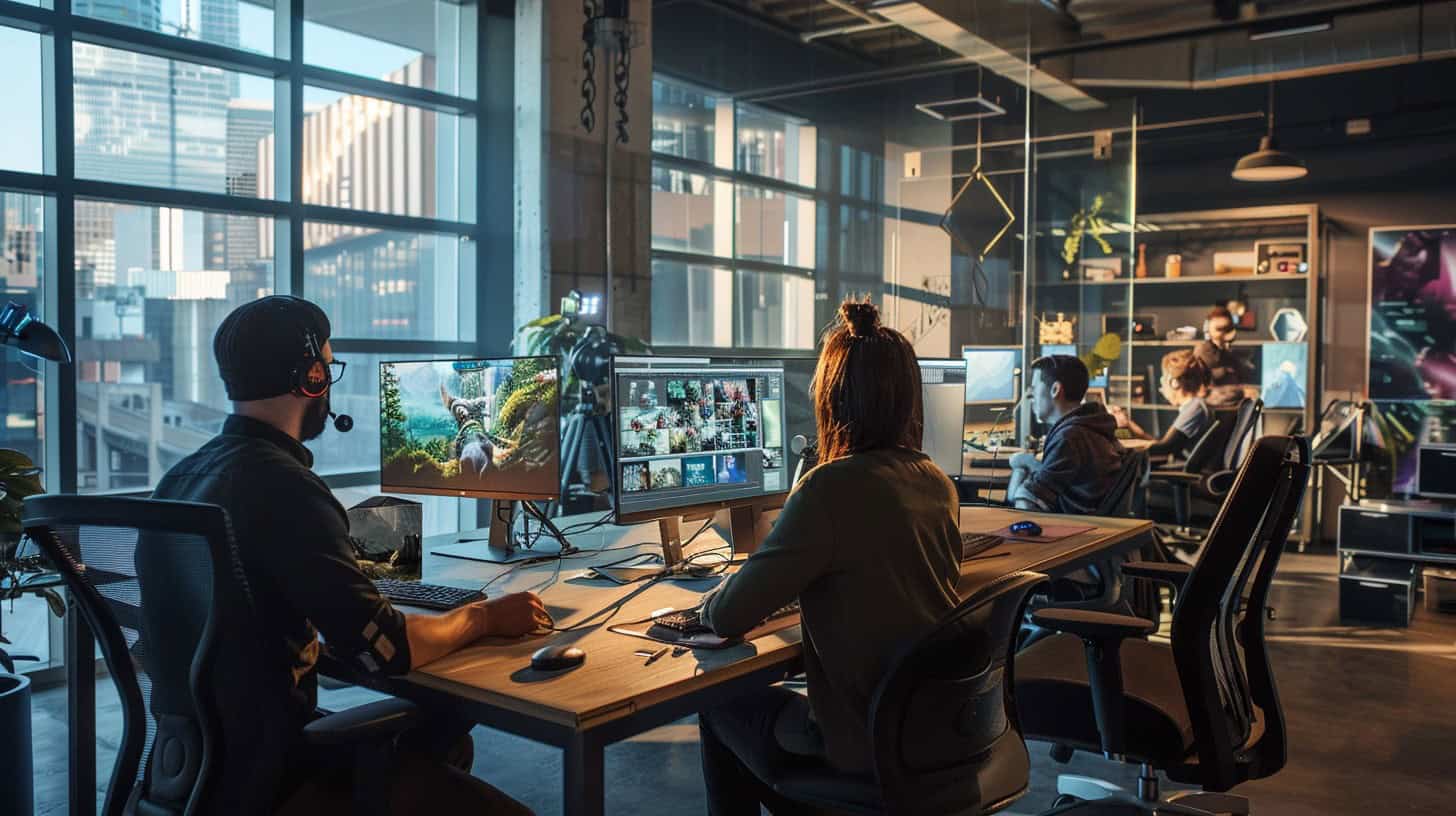Creating a video game can seem mysterious. The global video games industry hit $151 billion in 2019, showing its massive impact. This post will guide you through five key steps in turning bold ideas into playable realities, using tools like Unity and Unreal Engine.
Get ready to learn how!
Key Takeaways
Video games start with a team coming up with an idea and planning everything from who will play it to how it will make money. They use documents like the Game Design Document (GDD) for guidance.
Teams build video games in stages, starting with simple versions called prototypes. They test these early versions to see if people enjoy them before making the game better.
Artists and programmers work together to create the look, feel, and action of the game. They use tools like Unreal Engine for 3D effects and programming languages such as C++ or Python.
Sound designers add music and effects to make the game world feel real. Testers play through, trying to find any mistakes that need fixing before everyone can play it.
Once a video game is done being made, developers keep working on it after launch by fixing bugs and adding new content, so players stay interested.
Table of Contents
Exploring the Game Development Process
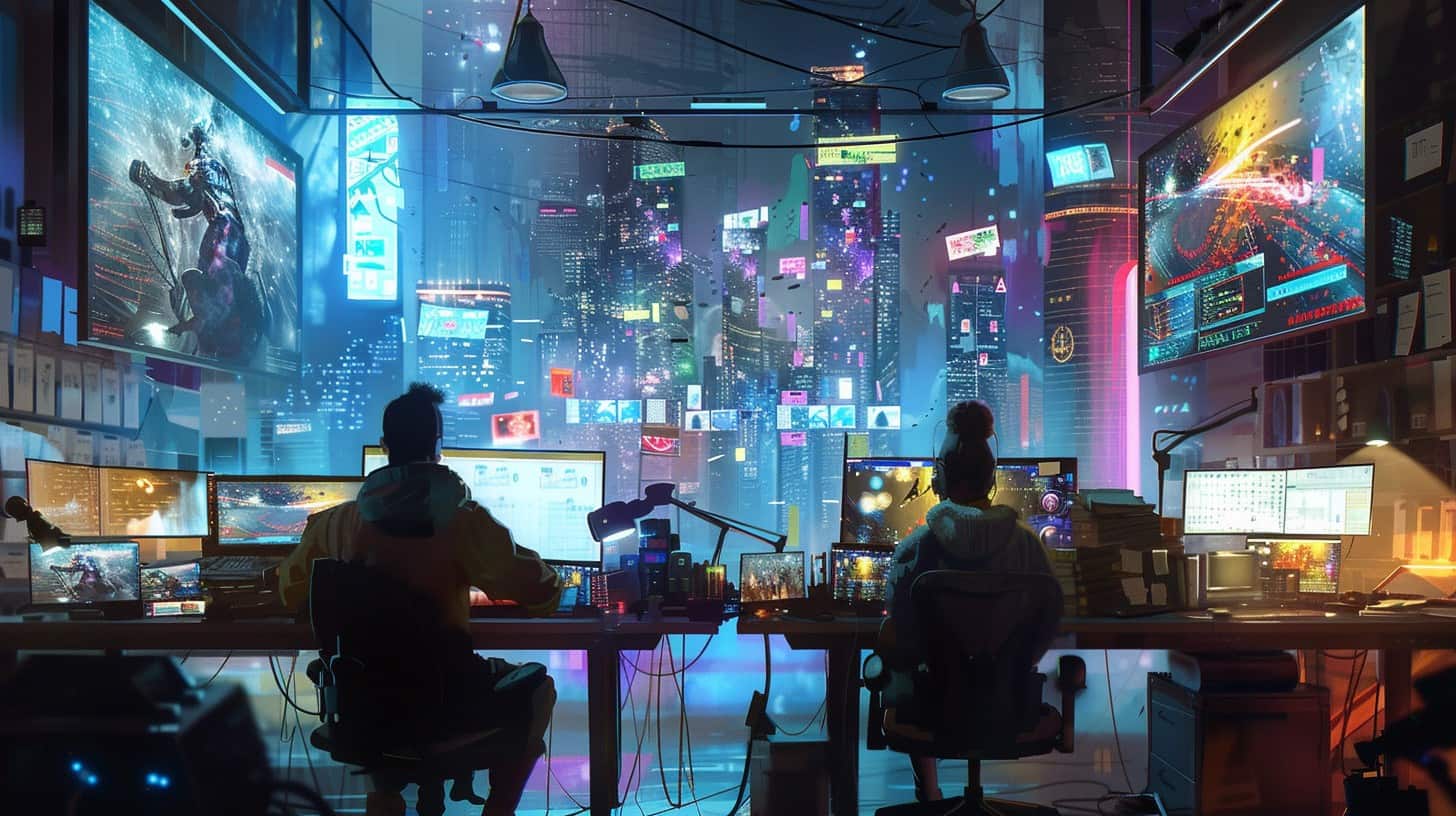
Making a video game starts with an idea, then turns into something you can play. It involves steps like planning in pre-production, making the game in production, and fixing it up after in post-production.
Entering Pre-production
Entering pre-production is the first step in creating a video game. This phase lays out the groundwork for everything that follows.
- Define the game idea: A small team, including a producer, programmer, and concept artist, comes together. They decide what kind of game it will be.
- Identify the audience and market: The team chooses who will enjoy their game the most and where to sell it.
- Pick platforms: Deciding whether the game will be on computers, gaming consoles like PlayStation or Xbox, or mobile phones narrows down tech needs.
- Plan how to make money: Will players buy the game once or spend money inside the game? This decision affects design.
- Set development time, resources, and budget: Knowing how much time and money they have helps plan what’s possible.
- Create a Game Design Document (GDD): This document is a guide that describes everything about the game.
- Test with prototypes: Early versions of the game help test if ideas are fun and doable.
Talking about online casino gaming design, both traditional video games and games like those on offshore poker sites have much in common but also differ significantly. Both require creativity, engaging gameplay mechanics, and captivating visuals to attract players. However, designing for online casinos often involves understanding gambling behaviors and incorporating elements of chance in ways that are fair yet unpredictable – contrasting with traditional video games where skill progression can be more linear and controlled.
Engaging in Production
Engaging in production is the core phase of video game creation. It transforms ideas into playable experiences.
- Game developers refine the story, making it compelling for players.
- Artists, including those skilled in animations and 3D models, get busy crafting characters, environments, and objects. They use tools like Blender and Photoshop to bring visuals to life.
- Programmers write code that makes everything in the game work. They often use languages like C++ or Python, alongside engines such as Unity or Unreal Engine 4.
- Sound designers create audio effects and music that match the game’s atmosphere. Tools like GIMP are used for generating soundscapes.
- The team builds levels and maps where the action will take place, using level editors for precision.
- Continuous testing starts early to catch bugs and glitches, ensuring a smooth gameplay experience.
7.domain experts ensure the game mechanics are fun and engaging.
8.video game testers play over and over to find problems in detail.
This stage requires teams to blend creativity with technical skills effectively—using feedback to polish every aspect until it shines.
Completing Post-production
Post-production wraps up the video game creation cycle. It ensures games meet quality expectations before hitting the market.
- Teams fix bugs that testers find. This makes the game run smoothly.
- Developers create patches for problems found after the game launches. Patches help keep players happy.
- Bonus content gets developed, providing extra value to gamers. This includes downloadable content (DLC) for adventure games like The Sims 4 or Fortnite Battle Royale.
- The game reaches its gold master stage, signaling it’s ready for release. Everything must be perfect by this point.
- Quality assurance teams play through the game again, making sure all fixes work as expected.
- Sound designers tweak audio levels and effects, ensuring the best possible user experience.
- Artists make last-minute adjustments to visuals, polishing graphics and interfaces.
- Programmers optimize code for better performance on PCs, consoles like Nintendo Wii, and mobile games on platforms like Google Play Store and Apple Store.
- Marketing strategies ramp up to build excitement among the target audience through social media and influencers.
- Community managers engage with fans online, gathering feedback and building hype around the release.
- Development leads hold debrief sessions to review what went well and what could improve for future projects.
Each step is crucial to deliver epic games that entertain and engage players worldwide, showing how teamwork brings creative visions to life in gaming companies from indie developers to major studios using tools like Unreal Engine 5 and Godot for wide-ranging platforms from PC games to handheld systems.
Essential Roles in Game Development
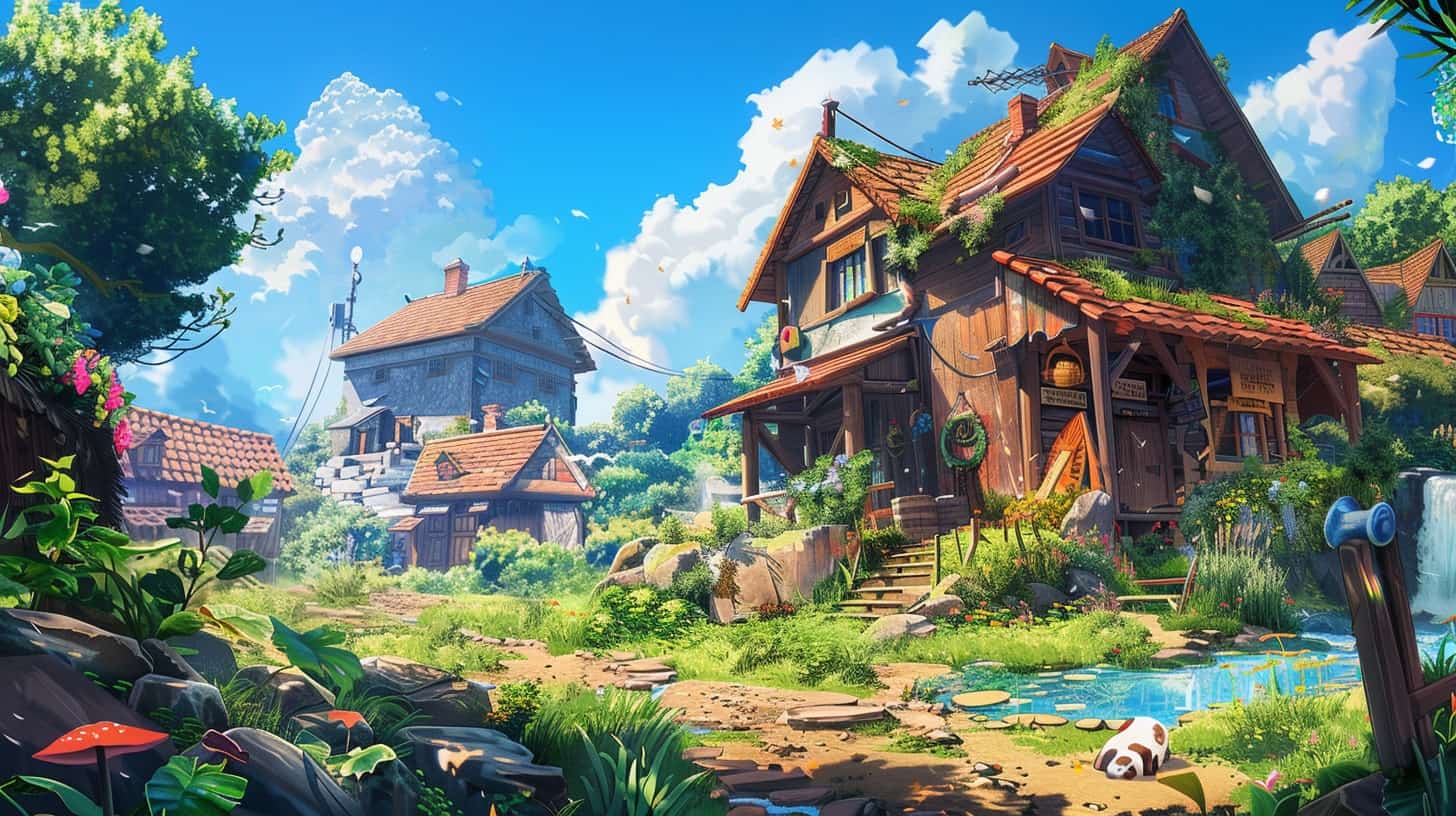
In making a video game, different people do special jobs to bring the game to life. Designers dream up the game’s world, programmers write the code that makes everything work, artists create visuals and scenes using tools like Adobe Photoshop, sound engineers make music and effects with software like Audacity, and writers come up with stories and dialogues that pull you in.
The Role of Game Designers
Game designers craft the core of every video game. Their work involves dreaming up stories, characters, goals, rules, and challenges. They ensure players will find the game fun and engaging.
These designers also work closely with other team members – like level designers who shape the game’s stages and programmers who build the game’s mechanics using languages like Unity Engine or Gamemaker: Studio.
Game design is translating creative visions into playable reality.
They provide detailed plans and documents to guide the production process. This ensures that everyone on the team understands how to bring their ideas to life in a cohesive way. Next up, we explore how programmers turn these designs into interactive experiences.
The Work of Programmers
After game designers map out what a game should look like and how it should play, programmers bring these ideas to life. They write the code that turns concepts into interactive experiences.
Programmers deal with the nuts and bolts of video games, such as how characters move and how levels are structured. They use programming languages, ensuring that every part of the game works well on different devices.
Programmers also tackle artificial intelligence (AI) for non-player characters, making them seem smart in the game world. They work with engines and tools like Unity or Unreal Engine to build the game’s framework from scratch or modify existing ones.
These experts make sure that everything from jumping to solving puzzles feels right in players’ hands. Their role is crucial for crafting smooth-running games across PCs, consoles like Xbox Live and PlayStation, smartphones, and more unique platforms.
The Artistry of Artists
Moving from the coding world, artists play a key role in game creation. These talented people use tools like Inkscape and Adobe Illustrator to make games come alive. They work on everything visual – from characters to backgrounds.
Imagine playing your favorite sandbox game or exploring open-world spaces without their stunning visuals! That would be dull, right? Artists add color and details that pull you into the game’s universe.
They don’t just draw things; they also design how every frame looks and feels. With 75-90% of a game’s budget going toward artwork, it’s clear how important this is. Think about the last epic game you played—maybe it was something with breathtaking landscapes or intricate character designs.
That level of detail comes from hours of hard work by concept artists, 3D modelers, animators, and FX experts who shape the game’s identity through its aesthetics.
The Craft of Sound Designers
Sound designers are key in making video games. They create the sounds that make the game world feel real. This includes music, effects, and voices. Their work is vital for an immersive experience.
For example, the sound of footsteps or wind in a forest can pull players deeper into the game.
They use audio tools and work with artists and programmers to make sure their sounds fit perfectly with visuals. This teamwork makes the game come alive for players around the globe.
Sound design gives life to our favorite virtual worlds.
Next, we explore how writers add depth to these worlds through storytelling.
The Contributions of Writers
Moving from the craft of sound designers, writers play a crucial role in video game creation. They pen down the narrative, dialogue, and lore that make games more than just visuals and sounds.
These creators ensure stories flow seamlessly with gameplay mechanics, making every quest meaningful.
Writers work closely with game designers. This collaboration brings life to interactive tales where players feel part of the world. Their words craft heroes and villains that gamers love or loathe.
Through their scripts, players experience epic journeys in worlds like those seen in “The Legend of Zelda” or face challenges inspired by “Metroid.” In essence, writers give voice to the silent pixels on screen, turning simple missions into memorable adventures that echo beyond the game console.
Steps in the Game Development Pipeline

In game creation, the journey starts with a spark—turning cool ideas into game plans. Artists sketch while coders type, bringing worlds to life on screens… First up, dream teams jot down their wild thoughts and draw the roadmap.
Then, they craft a basic version to play around with—testing what’s fun and fixing what’s not. Using tools like Unreal Engine for building scenes and Adobe for making things look awesome helps a lot.
Programming languages get everything moving just right.
As feedback rolls in, teams tweak and polish until it shines. Finally, every detail from button pushes to background music gets checked. Done? Almost—now it’s time to share the adventure with gamers everywhere!
Generating Concept Ideas
Generating concept ideas involves thinking up the story and mechanics that make a game unique. Teams brainstorm to come up with original concepts, often starting with basic themes or genres—like adventure, puzzle, or action.
They consider what makes games like Super Mario Bros and Donkey Kong engaging. Ideas go from broad to specific, focusing on creating memorable experiences for players.
Great games start with great ideas.
Developers use tools like storyboards and sketches to visualize their ideas. They think about the gameplay elements that will challenge and entertain players. Prototyping tests these early concepts, using simple designs to check if an idea is fun.
This stage might use placeholders instead of final art or sounds. It’s crucial because some games don’t make it past here if they’re not exciting enough.
Creating Design Documentation
Creating design documentation is a crucial step. This document acts as the game’s north star. It makes sure everyone shares the same vision throughout development. The Game Design Document (GDD) lists everything about the game.
It covers game mechanics, storylines, and how the tech works.
To make one, you need to know your tools well. Game engines and graphic design tools are important here. Think of using popular engines like Unity or Unreal Engine for simulations in your games.
For visuals, Adobe Photoshop helps bring textures and characters to life. With these tools, designers outline their visions clearly in the GDD.
This process ensures that every team member knows what to do. It keeps artists, programmers, and sound designers on track. They all use the GDD to check if their work fits with the game’s big picture.
Building Prototypes
Making prototypes tests how the game works. It checks if the gameplay, mechanics, and looks are good. Teams use simple things instead of final ones to try out ideas. This finds problems early.
They make a first playable version with better things and images next.
Then, they test the game and get people’s thoughts. This helps make the game even better before it’s done.
Conducting Testing and Gathering Feedback
After crafting a game prototype, the next step is to test it and get feedback. This phase ensures that the game works well and is fun to play. Video game testers play an essential role here.
They spend hours finding bugs in games to make sure everything runs smoothly. Their goal is not just about catching glitches, but also checking if the game makes sense and keeps players engaged.
For feedback, developers turn to beta testers—real gamers who provide thoughts on their experience. Beta testing focuses more on polishing than adding new stuff. It’s crucial for optimization before the final release.
Through this process, teams collect valuable insights from players, helping fine-tune gameplay, fix any problems, and ensure the overall quality of the video game.
The goal of testing isn’t just finding bugs; it’s ensuring a seamless and engaging player experience.
Finalizing Game Elements
Finalizing game elements means making sure everything in the game works perfectly. Game engines like Unity and Unreal Engine help put all parts of the game together, from character movements to levels.
Graphic design tools bring visuals to life, while audio tools add sound effects that make the game feel real. Programmers use languages such as C++ or Python to fix any problems and add final touches.
Before a game goes public, it goes through alpha and gold master stages. At alpha, the game has all its features but might still have bugs. Testing finds these bugs, so developers can fix them.
The gold master stage is when the game is ready for players around the world. Developers also work on bonus content during this time, keeping games fresh and exciting for players.
Tools and Technologies in Game Development
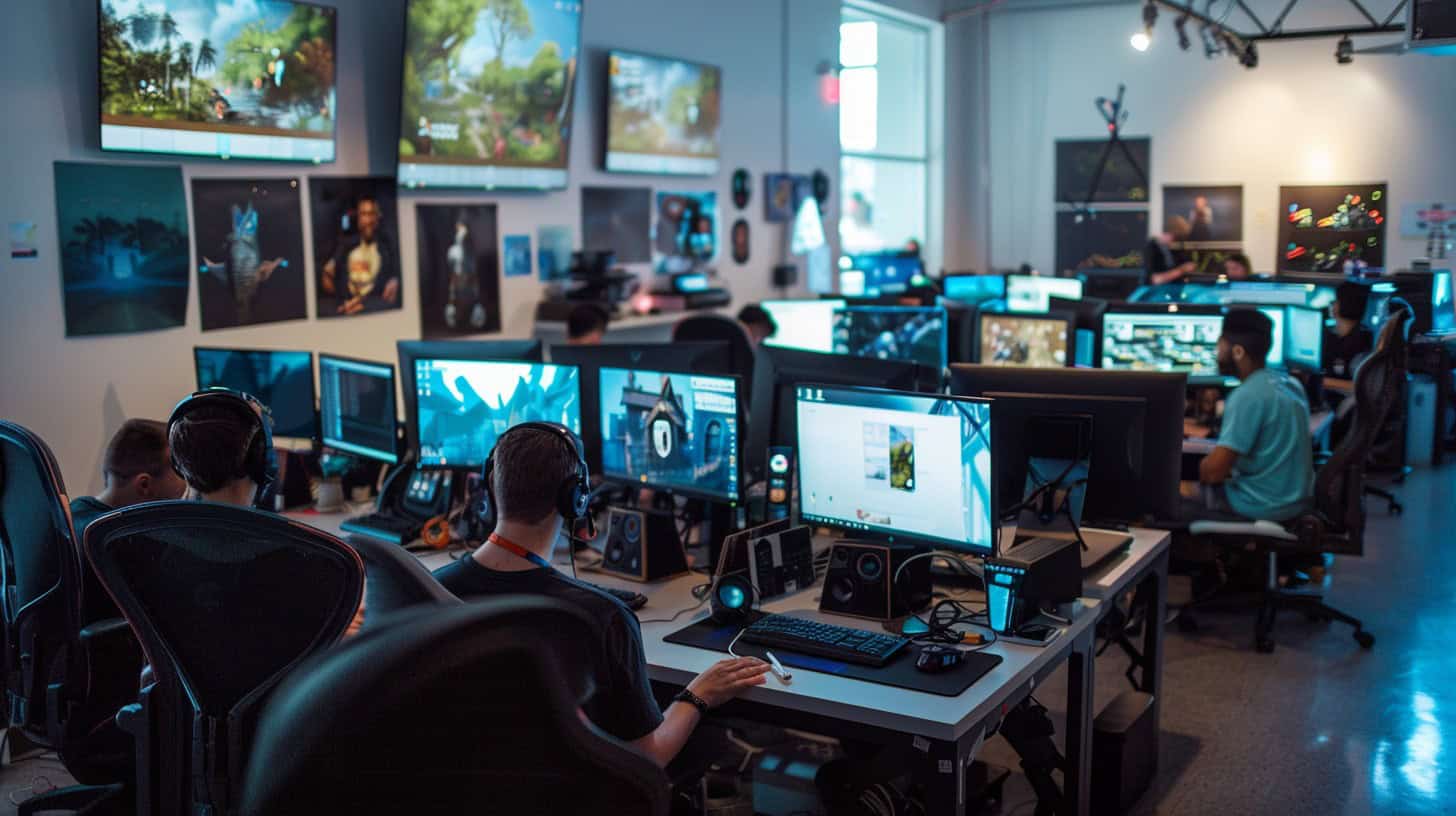
In making games, developers use special software and languages. They choose game engines like Unreal Engine for creating worlds, graphic design programs for making visuals, sound tools for effects and music, and coding languages to bring it all to life.
Utilizing Game Engines
Game engines like Unity and Unreal Engine are must-haves for creating epic games. They let developers build both 2D and 3D worlds, making them flexible tools in game crafting. These engines come packed with features that support animation, physics, and even multiplayer settings.
This means a single engine can handle almost everything needed to bring a game to life.
Unity is great for indie games because it’s easy to learn and has a big community ready to help. Meanwhile, Unreal Engine offers top-notch visuals that major studios love for their blockbuster titles.
Both have online courses available, making it easier than ever to master these engines.
The right game engine breathes life into your vision.
Employing Graphic Design Tools
Graphic design tools like Photoshop and Blender help make visual assets for games. These programs are key for creating textures, models, and animations. Artists use these tools to bring game worlds to life in both 2D and 3D formats.
Textures wrap around models to give them color and detail, while animations move everything on screen. With these technologies, artists craft the look of everything from epic landscapes to detailed characters.
This process ensures games are visually stunning and immersive for players.
Implementing Audio Tools
Game developers use audio tools like Pro Tools and Audacity for sound effects. They record, edit, and mix sounds with these programs. Composers pick software such as FL Studio and Logic Pro to make music.
These choices allow them to create deep soundtracks that bring games to life.
For each game, integrating sound happens carefully. Developers place background tunes and effects at just the right spots. This step makes sure players feel every jump, explosion, or whisper in a way that’s sharp and clear.
Using these audio tools correctly takes skill but adds a big layer of fun to playing video games.
Applying Programming Languages
Programmers use C++, C#, and Python to make video games. They write code for game rules, how characters move, and the game world’s layout. This code helps games work well on computers, consoles like Gameboy and PlayStation, and even phones.
For example, using C++ might help create fast-paced action in arcade games or complex worlds in open-source RPGs.
Choosing the right programming language affects everything from how players control their characters with a keyboard or controller to ensuring the game doesn’t crash during an epic battle.
Programers have to think about what platform their game will be on—whether it’s Steam for PC gamers or the Apple Store for iPhone users—and pick languages that best suit those environments.
Phases of Game Production
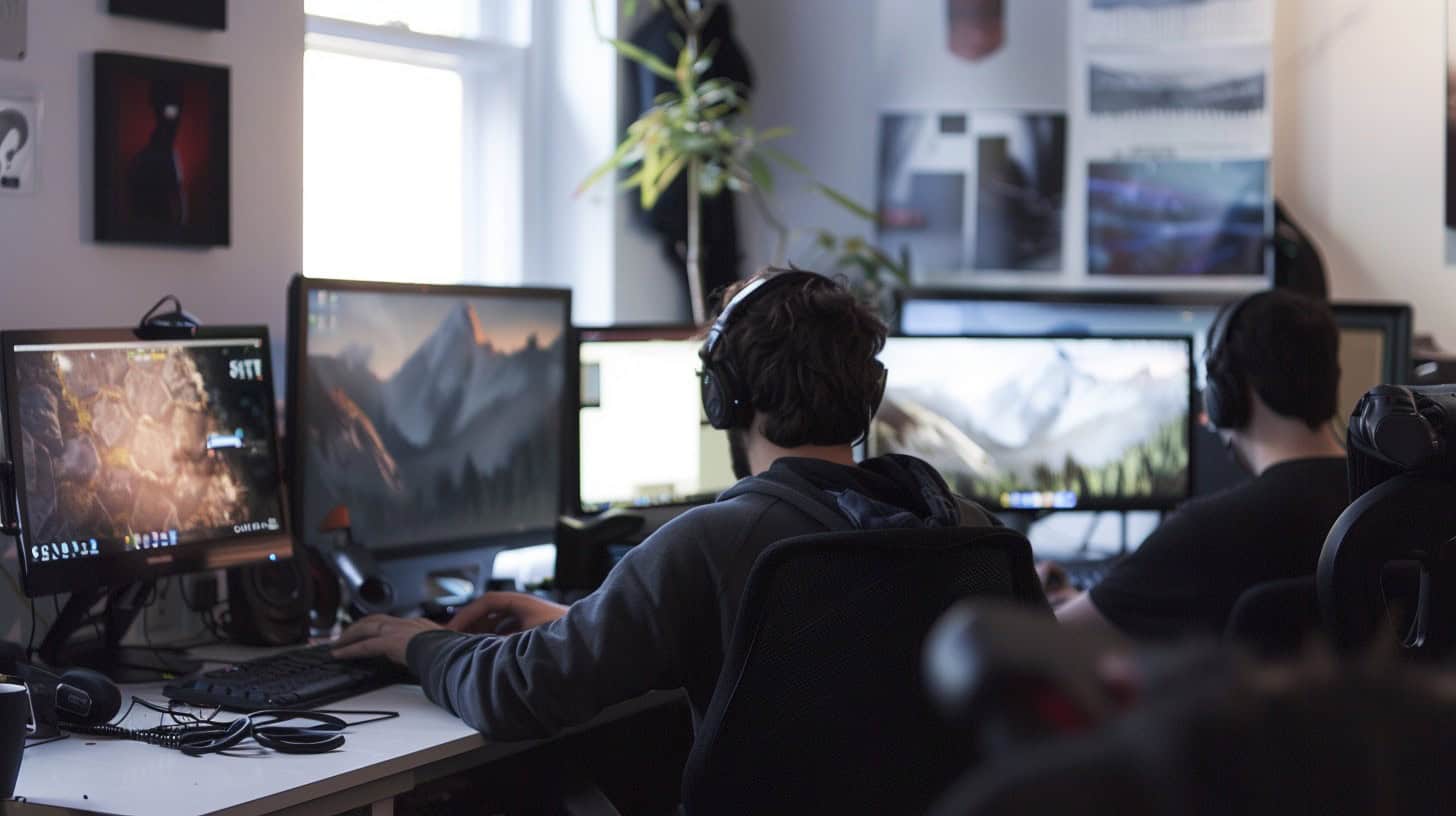
In game making, teams go through many steps to make a game. They start with cool ideas and drawings, then use special computer programs and coding to build the game.
Formulating Initial Concepts and Designs
Teams start with a spark of an idea. They think about the kind of interactive game they want to make. This could be anything from platformers to tower defense games. Then, they decide who will play their game and where it can be played, like on console games or computer.
They also plan how to make money from the game, choosing between selling it outright or adding in-game purchases.
Next, creators use tools like game engines and graphic design tools to bring their vision to life. For example, Unreal Engine might be used for creating stunning 3D environments, while Adobe Photoshop helps artists draw characters and worlds.
The goal is clear – create a Game Design Document that guides everyone involved in making the video game developer’s dream come true.
Now onto developing assets and integration…
Developing Assets and Integration
Game artists work hard on artwork, using 75-90% of the game budget. They draw concept art and create animations and 3D models. These visuals are key for making a game that looks good.
The first playable version of the game replaces simple placeholders with these detailed assets and art. This step is huge in bringing the game to life.
During asset integration, programmers use various programming languages to add these assets into the game engine. Tools like Epic Games’ Unreal Engine help blend all elements together smoothly.
This process makes sure everything from visuals to sounds works well together. As a result, players get a seamless experience when they play the demo or final product.
Executing Coding and Programming
Programmers take game designs and make them real with code. They build the game’s mechanics, teach characters how to act, and create the world players explore. Using languages like C++ and Python, they write lines of code that control everything in the game.
Tools such as Unity or Unreal Engine help programmers bring characters to life and shape the game environment.
By the time a game reaches its alpha stage, it means all major features work thanks to programming. Programmers fix bugs, add smaller details, and make sure everything runs smoothly.
They work closely with designers, artists, and sound engineers to polish every part of the game until it shines for players to enjoy. Every line of code is crucial for taking a concept idea from paper to screen, where gamers across the globe can experience new adventures.
Performing Quality Assurance and Testing
Quality assurance and testing are key steps in game development. Testers play games to find bugs. They make sure the game works well. During this phase, they focus on making the game better, not adding new parts or features.
This part is very important for a smooth game experience.
Testers use different tools and engines to check the game. They look at every detail to catch any issues early. The goal is to fix problems before players see them. This makes games fun and free from errors when they launch.
Strategies for Marketing and Release
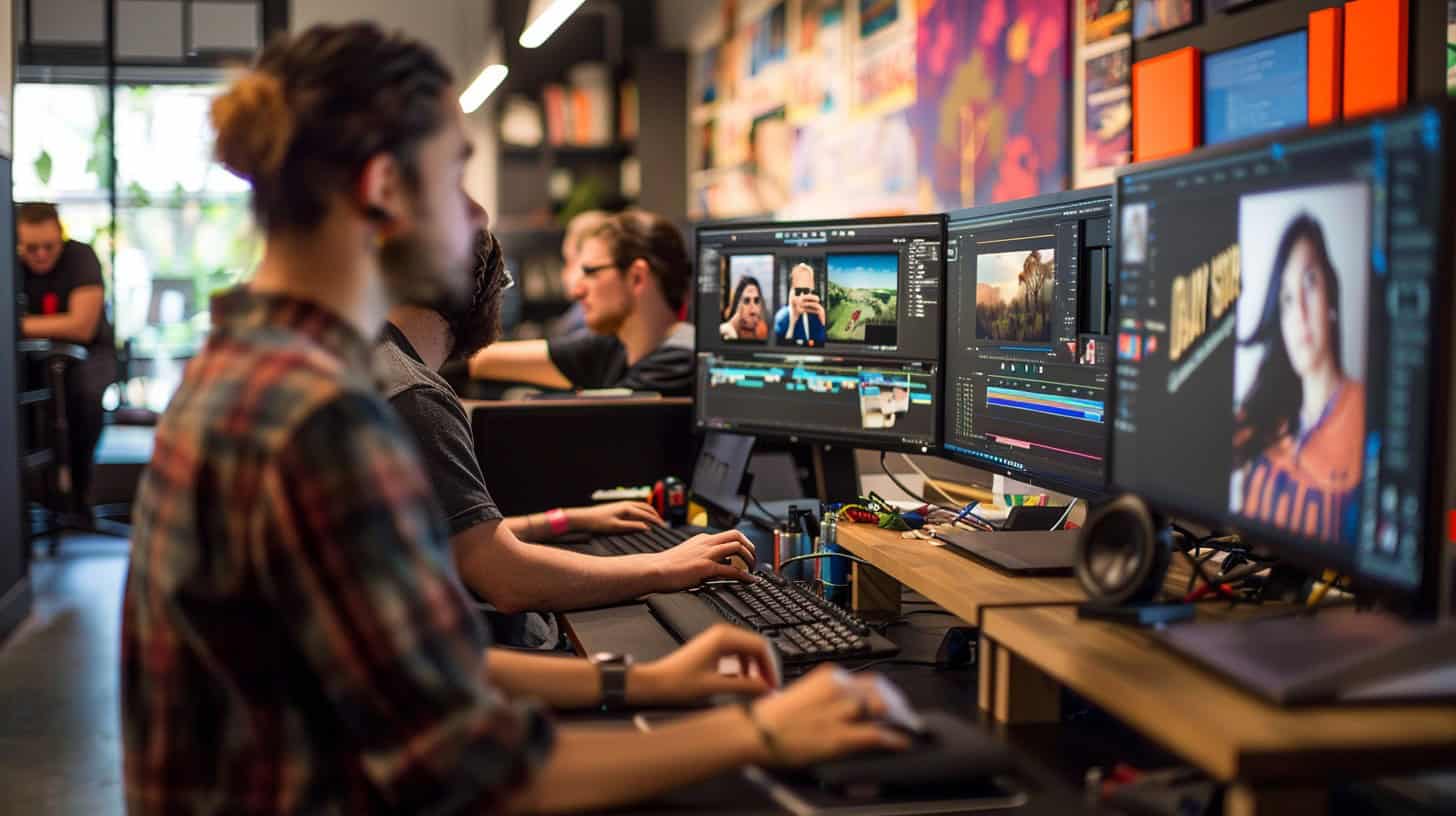
Getting the word out and keeping players hooked after launch matters a lot.
Crafting a Marketing Plan
A good marketing plan uses social platforms and early game builds. This gets the word out early. It makes sure more people see the game. We start sharing on platforms like The Internet and use email to send updates.
Making videos helps too.
Creating buzz is key. We talk with our community online, show them sneak peeks, and ask what they think. This keeps them excited and spreads the word more. Next up, we focus on building a strong community around the game….
Fostering Community Engagement and Obtaining Feedback
Engaging with players through forums, social media, and beta phases is key. These platforms allow developers to hear directly from their audience. Players share thoughts on what excites them and where they see room for improvement.
This direct line of communication helps craft a better game experience.
Beta testing opens the door for a select group to try the game before its release. Feedback from this phase guides developers in tweaking gameplay, fixing bugs, and polishing details to ensure the game meets player expectations.
Tools like online surveys gather specific feedback, making it clear what works well and what doesn’t. This process proves invaluable in fine-tuning games to match player desires closely.
Managing Launch and Post-Launch Support
Launching a video game means you’re ready to show your hard work to the world. The gold master stage is the final step, meaning the game is complete and set for release. After this, it’s crucial to keep players interested with continuous support and updates.
This includes fixing any bugs that pop up, releasing patches to improve gameplay, and adding bonus content for an enhanced experience. Players expect new challenges and surprises after launch.
For example, using digital distribution platforms helps get your game into players’ hands quickly. Tools like Epic Games provide ways to push updates efficiently. It’s also essential to listen to feedback from your community through social media or forums like Open-Source Programs.
Engaging with players keeps them invested and can guide what kind of post-launch support or content you develop next. Quick action on bug fixes based on player reports shows commitment and can turn casual gamers into loyal fans.
Overcoming Challenges in Game Development
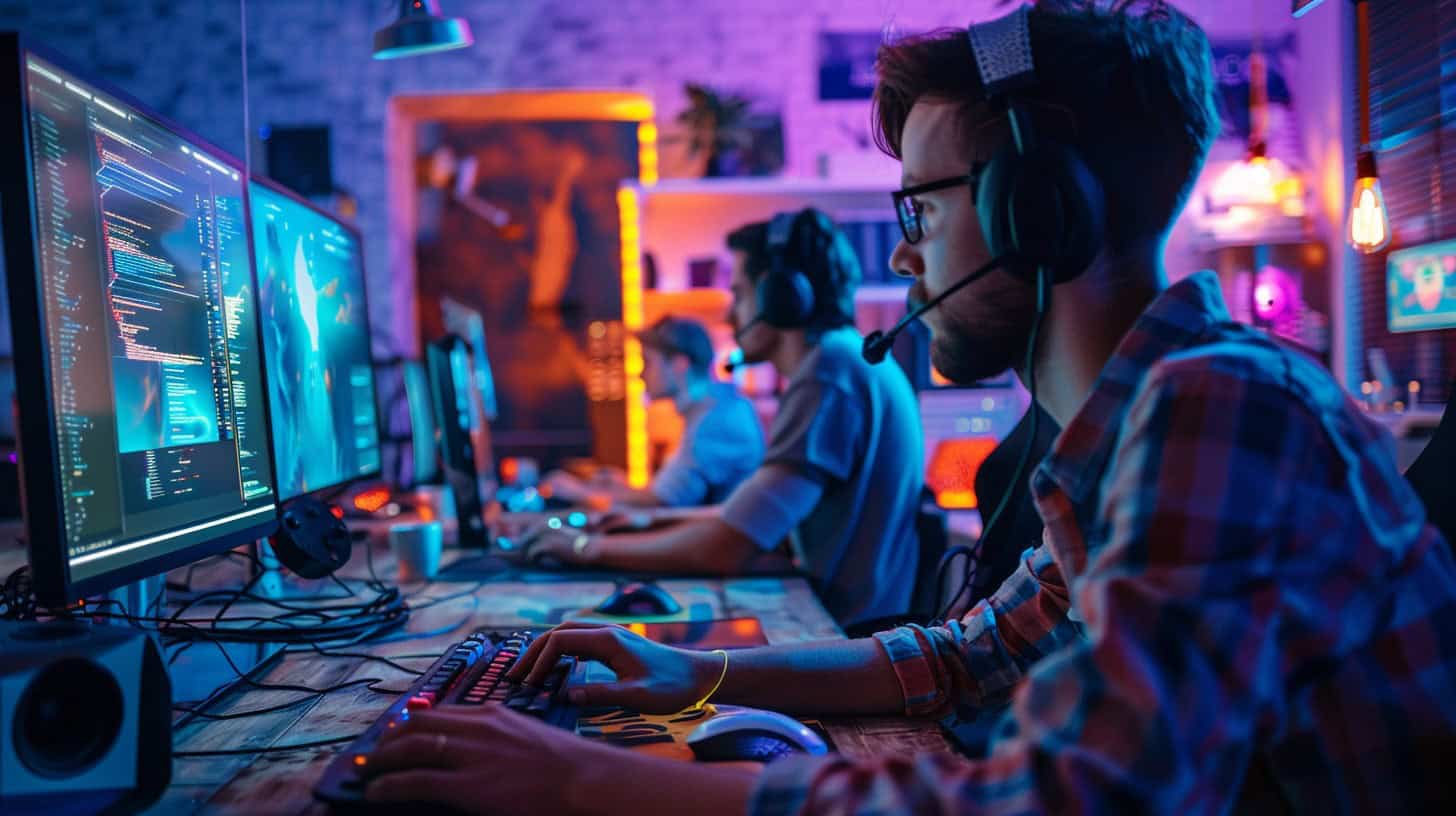
Creating games is tough. You face limits in what you can make and how long it takes. You need to keep your game fun and easy for everyone to play. To win at this, manage your team’s time and budget well.
Also, pick the right tools like game engines, graphic design software, audio tools, and programming languages. They help a lot.
Managing Creativity and Technical Limits
Balancing creative ideas with what is technically possible is key in video game development. Game designers dream up big ideas. Yet, programmers face the challenge of making these ideas work on devices like computers and gaming consoles.
They use programming languages and game engines to turn visions into playable games. Sometimes, the original idea needs changes to fit technical limits.
Using tools like Epic Games’ Unreal Engine helps manage these challenges. This powerful tool lets creators build amazing worlds while keeping an eye on performance limits and device capabilities.
Programmers, artists, and sound designers work together closely. They tweak their creations until everything runs smoothly without losing its fun or appeal. Through testing phases, they spot problems early and fix them efficiently—making sure games not only look good but also play well on all intended platforms.
Handling Timelines and Budgets
After tackling the balance between creativity and tech limits, we face timelines and budgets. Staying on schedule is key. The pipeline sorts tasks, saves time, and avoids delays. Most game costs pour into artwork—75 to 90 percent.
Planning well means using money right and keeping deadlines.
Game teams pick tools like engines for building games fast. They set clear dates for each phase: concepting, testing, launching. Every step has a budget slice. If they spend too much early on, less is left for later, like marketing or fixing bugs.
So, they track every dollar and adjust plans as needed to ensure the game reaches players without any hitch.
Ensuring Playability and Accessibility
Moving from sorting out timelines and budgets, games must also be easy to play and open to everyone. Video game testers step in here. They play through the game many times. Their job is to find any bugs that could spoil the fun.
They check each part of the game carefully.
Making a game enjoyable for all kinds of players is key too. This means adding features, so more people can have fun playing it. For example, designers might add subtitles or ways to change controls easily.
These steps make sure everyone has a good time with the game, no matter who they are or how they play.
People Also Ask
What starts the video game creation process?
Ideas come first. Thinkers like Shigeru Miyamoto and Gunpei Yokoi brainstorm concepts, leading to iconic games. They consider gameplay, story, and characters.
Who designs the game’s look and feel?
Artists and computer scientists collaborate closely here. They use tools for simulating environments, crafting user interfaces, and designing assets that make games like Earthbound visually appealing.
How do programmers bring a video game to life?
Lead programmers, alongside software engineers like Genyo Takeda and Satoru Iwata, write code that turns ideas into playable formats. This involves complex tasks from creating algorithms for movements to ensuring compatibility across devices like iPhone or Mac OS X.
What ensures a game is fun but challenging?
Testing—a crucial step where teams play pre-alpha versions to find bugs and assess difficulty levels—ensures playability and accessibility for all gamers using various controllers from D-pads to keyboard and mouse setups.
How does a new video game reach players?
Marketing strategies kick in after development; this includes choosing the right business model, planning monetization tactics such as in-game purchases or ads, setting up creative commons licenses where applicable, rating the game E10+ if it fits—all these help spread the word through channels like social media or word of mouth.
What roles does feedback play post-launch?
Developers listen to player input on open-source programs or forums to refine gameplay further—whether it’s adjusting difficulty levels or porting games for better performance on different systems (think switching from PC gaming rigs to handheld devices). Continuous updates keep titles fresh long after their initial release.
